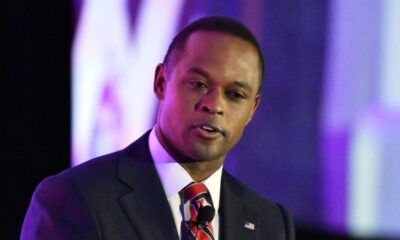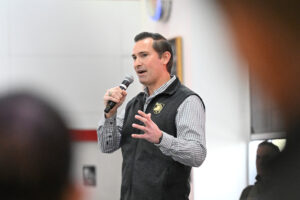The Dictatorship
Florence Pugh’s surprise diagnosis highlights the downsides of a patriarchal health system

A recent account from Oscar-winning actress Florence Pugh is a sober reminder that even with exceptional levels of fame and resources, women overwhelmingly lack basic tools to understand our own bodies, and overall health.
After experiencing some difficult to place symptoms, Pugh visited a doctor, who suggested she undergo an egg count test — an unusual recommendation for someone who is only 27. The test ultimately led to a diagnosis of both polycystic ovary syndrome (PCOS) and endometriosis. Pugh reportedly was shocked, but also relieved — it finally made sense, she told her physician Dr. Thaïs Aliabadi on the “SHE MD” podcast that Aliabadi hosts with Mary Alice Haney. For years, Pugh had dealt with symptoms like unusual hair growth and acne, which she had attributed to “being a woman” with a “slightly stressful life.” As it turned out, it wasn’t all in her head.
Suddenly, she was forced to think about her future and her fertility, something she had assumed she had nearly a decade to consider.
In the same podcast episode, Pugh described the diagnosis as a “mind-boggling realization.” Suddenly, she was forced to think about her future and her fertility, something she had assumed she had nearly a decade to consider. Advised to freeze her eggs, she followed through and is now sharing her story to encourage other women to take charge of their reproductive health and lives.
When I froze my eggs and documented the process for Armchair Expert’s “Race to 35,” I was struck by how difficult it was to get clear answers about my own body and how much of the responsibility fell on me to figure it all out. I was sent home with a collection of hormones and needles and expected to adhere to a rigorous regimen and mixing schedule, with the warning that a mistake could ruin the entire process. The mental strain of the entire ordeal felt more taxing than the physical toll it was taking to inject myself everyday and get blood tests and transvaginal ultrasounds every 72 hours.
I remember thinking that if men had to freeze their eggs, the service would include a personal nurse, a therapist, a chef, a driver, and probably a life coach. The potential for errors, and the high stakes attached, was staggering, especially given the often prohibitive cost of the procedure. Why are women expected to know so much with so little support?
Part of it is social conditioning. Women are so often seen as caretakers, not the ones who need to be cared for. The data reflects this patriarchal misconception. Women are more likely to be misdiagnosed than menand their ailments receive less research funding. Endometriosis, the condition affecting Pugh and an estimated 1 in 10 women globallyis a stark example of gender disparities in medical research. A McKinsey report found that erectile dysfunction, despite being far less common, receives six times more research funding than endometriosis. From 2019 to 2023, erectile dysfunction was allocated $1.24 billion, while endometriosis received $44 million. It’s infuriating given that endometriosis has far more life-threatening impacts (it can cause ectopic pregnancies, bowel obstruction and even cancer) and that it impacts a larger portion of the population. Simply put, our priorities don’t reflect our needs.
And let’s be clear — the issue isn’t men; it’s the patriarchy. Women’s symptoms are disproportionately dismissed as psychosomatic, leading to a systemic lack of belief and trust in their own accounts of their health. This bias isn’t confined to male doctors; female doctors can also perpetuate it. Pugh, for instance, said she faced dismissal from a female doctor in the U.K. when she brought up her diagnosis. While studies show women are less likely to die under the care of female doctorsthe reality is that even women in medicine can underestimate or overlook female painreflecting the broader cultural tendency to belittle it. And this is far worse for women of colorwhose pain is ignored at even greater rates and can lead to far graver consequences for them.
So how do we solve this?
According to Dr. Elizabeth Comen, an Associate Professor of Medicine at NYU Langone and author of the book “All in Her Head: The Truth and Lies Early Medicine Taught Us About Women’s Bodies and Why It Matters Today,” the most important step women can take is to find a buddy. “I don’t care if you’re Einstein; you need to have somebody with you to advocate for you,” she told me over the phone. “When you’re worried and anxious, you need that support to help filter the information in context.”
Dr. Comen also emphasized the need to shed the specific, yet universal, shame women often feel about not knowing how to advocate for themselves, despite often being so skilled at advocating for others. “Whether it’s homeless women, royalty, or the heads of hedge funds, every woman has that story. Women can find sisterhood in that shared experience,” she said. “This work cannot happen alone.”
If it happened to Florence Pugh, it can happen to anyone. As we wait for our culture and medical establishment to catch up, women leaning on each other isn’t just support; it’s a quiet revolution.
The Dictatorship
White House hall of shame targets news outlets

NEW YORK (AP) — President Donald Trump’s White House is taking on the role of media critic and asking for help from “everyday Americans.”
The White House launched a web portal it says will spotlight bias on the part of news outlets, targeting the Boston Globe, CBS News, The Independent and The Washington Post in its first two “media offenders of the week.”
It’s the latest wrinkle in the fight against what Trump, back in his first term, labeled “fake news.” The Republican president has taken outlets like CBS News and The Wall Street Journal to court over their coverage, is fighting The Associated Press in court over media access and has moved to dismantle government-run outlets like Voice of America.
Trump has also engaged in personal attacks, last month alone saying “quiet, piggy,” to a female reporter who was questioning him on Air Force One, calling a reporter from The New York Times “ugly, both inside and out” and publicly telling an ABC News journalist she was “a terrible reporter.”
“It’s honestly overwhelming to keep up with it all and to constantly have to defend against this fake news and these attacks,” said press secretary Karoline Leavitt, who called the new web portal an attempt to hold journalists accountable.
After its debut, the White House asked for volunteers to submit their own examples of media bias. “So-called ‘journalists’ have made it impossible to identify every false or misleading story, which is why help from the American people is essential,” Trump’s press office said.
Devouring the media like hot french fries
Despite the attacks, Axios wrote this week that the mainstream media is ending the year as “dominant as ever” in capturing the president’s attention and setting Washington’s agenda, citing as one example The Washington Post’s reporting on military strikes against boats with alleged drug smugglers.
The irony is that Trump engages with reporters at a level he hasn’t seen with any other president in his lifetime, said Axios CEO Jim VandeHei, co-author of the report with Mike Allen.
“He’s always bitched about the media and the press,” VandeHei told The Associated Press. “He gobbles this stuff up like hot McDonald’s french fries. He’s a mass consumer of this. He watches it, he calls reporters, he takes calls from reporters. … That’s always been the contradiction with him.”
CBS, the Globe and The Independent were criticized for stories about Trump’s reaction to Democratic lawmakers who recorded a video reminding military members they were not required to follow unlawful orders. Trump accused the lawmakers of sedition “punishable by death.”
The White House said it was a misrepresentation to say Trump had called for their executions. The portal also said news outlets “subversively implied” that the president had issued illegal orders. The news articles they cited did not specifically say whether Trump had or had not ordered illegal activities.
Leavitt has been sharply critical of the Post’s story on Defense Secretary Pete Hegseth’s role in attacks on boats used by alleged drug smugglers in Central America. The portal this week accused the newspaper of trying to undermine anti-terrorist operations.
“Let’s be clear what’s happening here: the wrongful and intentional targeting of journalists by government officials for exercising a constitutionally protected right,” said the Post’s executive editor, Matt Murray. “The Washington Post will not be dissuaded and will continue to report rigorously and accurately in service to all of America.”
The new portal also contains an “Offender Hall of Shame” of articles it deems unfair and a leaderboard ranking outlets with the most pieces it objects to. Twenty-three outlets are represented, led by the Post’s six stories. CBS News, The New York Times and MS NOW, the network formerly known as BLN, had five apiece. No news outlets that appeal to conservatives were cited for bias.
Media watchdog welcomes the company
The conservative media watchdog Media Research Center, which has accused news outlets of having a liberal bias since 1987, welcomes the company.
“We’re pleased,” said Tim Graham, MRC’s director of media analysis. “It’s a stronger effort than Republican presidents have done before. I think all Republicans realize today that the media is on the other side and need to be identified as on the other side.”
VandeHei said about the portal, “I can’t think of anything I care less about. If they want to set up a site and point out bias, great. It’s called free speech. Do it. I don’t think it makes a damned bit of difference.”
What is damaging, VandeHei said, is a constant drumbeat of claims that what people read in the media is false. “It makes people suspicious of the truth and the country suffers when we’re not operating from some semblance of a common truth,” he said.
___
David Bauder writes about the intersection of media and entertainment for the AP. Follow him at http://x.com/dbauder and https://bsky.app/profile/dbauder.bsky.social.
The Dictatorship
Trump administration fails in latest bid to halt grants for school mental health workers

SAN FRANCISCO (AP) — A federal appeals court on Thursday rejected the Trump administration’s bid to halt an order requiring it to release millions of dollars in grants meant to address the shortage of mental health workers in schools.
The mental health program, which was funded by Congress after the 2022 school shooting in Uvalde, Texasincluded grants meant to help schools hire more counselors, psychologists and social workers, with a focus on rural and underserved areas of the country. But President Donald Trump’s administration opposed aspects of the grant programs that touched on race, saying they were harmful to students and told recipients they wouldn’t receive funding past December 2025.
U.S. District Judge Kymberly K. Evanson, ruled in October that the administration’s move to cancel school mental health grants was arbitrary and capricious.
The U.S. Department of Education and Secretary of Education Linda McMahon requested an emergency stay and on Thursday, a panel from the 9th U.S. Circuit Court of Appeals denied that motion.
The panel wrote in its decision that the government hadn’t shown it is likely to succeed based on its claims that the district court doesn’t have jurisdiction or that it will be “irreparably injured absent a stay.”
The grants were first awarded under Democratic President Joe Biden’s administration. The Education Department prioritized giving the money to applicants who showed how they would increase the number of counselors from diverse backgrounds or from communities directly served by the school district.
Stay up to date with the news and the best of AP by following our WhatsApp channel.
The Trump administration said in a statement after the ruling in October that the grants were used “to promote divisive ideologies based on race and sex.”
The preliminary ruling by Evanson, a U.S. District Court judge in Seattle, applies only to some grantees in the 16 Democratic-led states that challenged the Education Department’s decision. In Madera County, California, for example, the ruling restores roughly $3.8 million. In Marin County, California, it restores $8 million.
The Dictatorship
Trump will visit Pennsylvania next week to highlight his efforts to reduce inflation

WASHINGTON (AP) — President Donald Trump plans to travel to Pennsylvania on Tuesday to highlight his efforts to reduce inflation even as fears mount about a worsening job market and amid signs that Americans are still feeling squeezed by high prices.
A White House official said Trump would be making the trip to discuss ending the inflation crisis that he says was inherited from his predecessor, Joe Biden. The official spoke on condition of anonymity because the trip has not been formally announced. It was not immediately clear where in Pennsylvania Trump would be visiting.
Last month’s off-year elections showed a shift away from Republicans as public concerns about affordability persist. White House officials said afterward that Trump — who has done relatively few events domestically — would put a greater emphasis on talking directly to the public about his economic policies.
The president has said that any affordability worries are part of a Democratic “hoax” and that people simply need to hear his perspective to change their minds — an approach also embraced by Biden, who in early 2024 went to the Pennsylvania borough of Emmaus to take credit for economic improvements after inflation spiked in 2022.
The trip hints the dilemma faced by Trump. He wants to take credit for rewiring the U.S. economy with his large tariff hikes and extension of income tax cuts, but he also continues to blame Biden for the increase nationwide in inflation rates that occurred this year during his own presidency. Overall, inflation is tracking at 3% annually, up from 2.3% in April when Trump rolled out a sweeping set of import taxes.
“We fixed inflation, and we fixed almost everything,” Trump said at Tuesday’s Cabinet meeting. He called affordability “a hoax” that was “started by the Democrats who caused the problem of pricing.”
Trump won Pennsylvania narrowly last year with 50.4%, besting Democrat Kamala Harris by roughly 120,000 votes. The win was part of a broader sweep in battleground states that helped return him to the White House after his 2020 loss.
AP VoteCast, an extensive survey of voters in the 2024 election, found that 7 in 10 Pennsylvania voters were “very concerned” about the cost of food and groceries. Roughly half expressed the same degree of worry over health care costs and the price of gasoline.
While Trump can point to a decline in gasoline prices, he’s now facing inflationary pressures on utilities and a massive increase in insurance premiums for people who get their health care through the Affordable Care Act.
Pennsylvanians who buy their own health insurance coverage are likely to see their costs increase on average by 21.5% because of the expiration of tax credits tied to the Affordable Care Act, the state said in October.
Pennsylvania has yet to see the boom that Trump promised would instantly happen with his return to the White House.
The state has largely preserved its Biden era job growth under Trump, but its unemployment rate has risen to 4% from 3.6% over the past 12 months, according to the Bureau of Labor Statistics. There has been an increase of roughly 24,000 people who say they’re unemployed.
Annual inflation in the Philadelphia area is 3.3%, roughly the same as last year.
The Philadelphia Federal Reserve’s Beige Book in November documented an economy in decline, saying that hiring has flattened, warehouse workers are getting fewer hours on the job, inflationary pressures are coming from tariffs and sales of existing homes are decreasing. Separately, the regional Fed branch’s manufacturing survey last month showed that factory activity weakened.
The news outlet Axios first reported Trump’s plans to travel to Pennsylvania.
-

 Politics10 months ago
Politics10 months agoFormer ‘Squad’ members launching ‘Bowman and Bush’ YouTube show
-
Uncategorized1 year ago
Bob Good to step down as Freedom Caucus chair this week
-

 The Dictatorship10 months ago
The Dictatorship10 months agoPete Hegseth’s tenure at the Pentagon goes from bad to worse
-

 Politics10 months ago
Politics10 months agoBlue Light News’s Editorial Director Ryan Hutchins speaks at Blue Light News’s 2025 Governors Summit
-

 The Dictatorship10 months ago
The Dictatorship10 months agoLuigi Mangione acknowledges public support in first official statement since arrest
-

 The Josh Fourrier Show1 year ago
The Josh Fourrier Show1 year agoDOOMSDAY: Trump won, now what?
-

 Politics8 months ago
Politics8 months agoDemocrat challenging Joni Ernst: I want to ‘tear down’ party, ‘build it back up’
-

 Politics10 months ago
Politics10 months agoFormer Kentucky AG Daniel Cameron launches Senate bid









